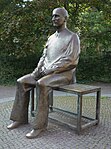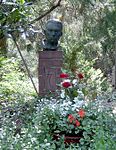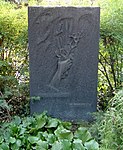Fritz Cremer
Fritz Cremer (born October 22, 1906 in Arnsberg ; † September 1, 1993 in Berlin ) was a German sculptor , graphic artist and draftsman , later Vice President of the Academy of Arts of the GDR .
family

Cremer was the son of the upholsterer and decorator Albert Cremer. One year after the death of the father, the mother Christine Cremer moved to Rellinghausen with the children Fritz and Emmy in 1908 . In 1911, the mother moved to Essen , where she married a teacher for the second time. After his mother died in 1922, Cremer lived with a family of miners.
Around 1930 the Austrian expressive dancer Hanna Berger became Fritz Cremer's partner. In 1942, Berger was arrested by the Gestapo as a member of Kurt Schumacher's / Rote Kapelle group . In 1944 she was able to escape from custody. She lived illegally in Styria until the end of the war .
In 1953 Cremer married the recently divorced painter and ceramicist Christa von Carnap (1921-2010), daughter of Alfred von Carnap (1894-1965), a businessman in Berlin-Wilmersdorf , and his first wife Susanne Schindler. Christa von Carnap's first marriage was to the Schöneberg sculptor Waldemar Grzimek .
Life

Cremer completed an apprenticeship as a stone carver with Christian Meisen in Essen from 1921–1925 after high school . During his subsequent activity as a stonemason , he made some sculptures based on models by Will Lammert and during this time attended plastic courses at the Folkwang School in Essen. In 1929 he joined the KPD and studied at the United State Schools for Free and Applied Arts in Berlin-Charlottenburg with Wilhelm Gerstel (1879–1963), whose master class he was from 1934 to 1938. During this time Cremer shared a studio with Kurt Schumacher , he made his first socially critical etchings . In 1934 he traveled to Paris . During a trip to London , Cremer met Bertolt Brecht and Helene Weigel there , who advised him to continue working in Germany. He was twice a guest at the Deutsche Akademie Villa Massimo in Rome , once in 1937/38 and a second time in 1942/43. At the Prussian Academy of the Arts, Cremer himself ran a master's studio. He was in close contact with the resistance group of the Red Orchestra around the sculptor Kurt Schumacher and the writer Walter Küchenmeister .
From 1940 to 1944 he was in the Wehrmacht as an anti-aircraft soldier in Eleusis and on the island of Crete , after which Cremer became a prisoner of war in Yugoslavia .
After his return to Germany, Cremer joined the SED in 1946 . Professionally, he was appointed professor and was appointed head of the sculpture department of the Academy of Applied Arts in Vienna . In 1950 he moved to the GDR and took over a master class at the Akademie der Künste , of which he was vice-president from 1974 to 1983. In the following period Cremer went on study trips to the Soviet Union , China and Egypt .
In 1976 Cremer signed the protest letter against Wolf Biermann's expatriation from the GDR, but withdrew his signature after a few days.
In 1956, Fritz Cremer and his student Gerhard Thieme removed Bertolt Brecht's death mask . As a result, numerous drawings, lithographs and busts were created. In 1988 Fritz Cremer's Brecht memorial was inaugurated in front of the Berliner Ensemble .
Cremer died in Berlin in 1993. His Berlin grave of honor is located in the Pankow III cemetery in Berlin-Pankow .
plant
Fritz Cremer's artistic work can be divided into two different thematic groups: On the one hand, a complex of works of public monument sculptures, on the other hand, sensual, intimate lovers and female nudes.
Among the monument sculptures, the memorials for the concentration camps play a central role. They testify to the sculptor Fritz Cremer's concern with the social task of the post-war period - commemorating the victims and coming to terms with National Socialism . People are at the center of all memorials. Cremer succeeded in visualizing deep human emotional states. Suffering, fear, despair, but also rebellion, resistance and strength are concretized in general archetypes. The grieving mother was just as much an expression of the war-related shock as the falling soldier.
In Fritz Cremer's work, the nudes and lovers form the thematic counterpart to the political commissioned works, and also served to calm him down and retreat into private life. They combine "tart traits and erotic sensuality", "closeness and affection, tenderness and fulfillment".
Stylistically, it cannot be assigned to either modernism or socialist realism . The aim of Cremer's artistic endeavors was to make the "mental constitution" of the sitter visible. For this reason, Cremer breaks with the idealized representation of the body, instead emphasizing its irregularities.
Factory overview
Sculptures and busts (selection)
|
|
Mauthausen memorial
Drawings and lithographs
- 1956: never again
- 1956: Walpursgis Night folder (36 sheets)
- 1962: self-portrait
- 1963: chalk circle
- 1966: Questions from a reading worker (on Brecht's poem)
- 1979: "Enough crucified!"
- 1986: Portfolio mother Coppi and the others, all!
- 1988: Fritz Cremer lithographs 1955–88
Book illustrations
- Beech forest. Studies by Fritz Cremer . Verlag der Nation, Berlin 1959.
- For mother Coppi and the others, all - graphic series. Henschelverlag Art and Society, Berlin 1986.
Exhibitions
|
|
Awards
- 1953: National Prize 2nd class for the bust of the miner and national prize winner Franz Franik
- 1958: National Prize 1st Class for the Buchenwald Monument
- 1961: Art Prize of the FDGB for the portrait bust of Bert Brecht
- 1965: Patriotic Order of Merit in Gold
- 1967: Honorary member of the Academy of Arts of the USSR
- 1972: Goethe Prize of the City of Berlin
- 1972: National Prize 1st class for the complete work
- 1974: Karl Marx Order
- 1976: hero of work
- 1978: Order of the Flag of the Hungarian People's Republic
- 1981: Bremen Sculpture Prize
- 1981: Gold medal for the Patriotic Order of Merit
Sculptures in Berlin and Brandenburg
Johannes R. Becher , Bürgerpark Pankow
Bertolt Brecht monument in front of the Berliner Ensemble
Heinrich Ehmsen's gravestone
Große Eva , Westend Clinic
A group of mothers in the Ravensbrück memorial
Own publications or exhibition catalogs
- Fritz Cremer: Lithographs 1955–1974. Academy of Arts, Berlin 1975.
- Catalog Fritz Cremer, Duisburg 1980.
- Catalog Fritz Cremer, Karl-Marx-Stadt 1986.
- Fritz Cremer: lithographs and etchings until 1988. Akademie der Künste, Berlin 1988.
- Catalog Fritz Cremer, Arnsberg 1991.
- Fritz Cremer: Just arguments? From writings, speeches, letters, interviews 1949–1989. Selected and commented by Maria Rüger. Publishing house for Berlin-Brandenburg, Berlin 2004.
- Catalog: Fritz Cremer - Sculptures and Drawings - Retrospective . With a contribution by Gerd Brüne, Edition Galerie Schwind, Frankfurt am Main 2009.
Literature on Cremer
- Bernhard Nowak: World of Art - Fritz Cremer ; Berlin 1965.
- Diether Schmidt: Fritz Cremer. Verlag der Kunst, Dresden 1973².
- Manuela Lintl: “Trümmerfrau” and “Construction Helper” by Fritz Cremer in front of the Red City Hall . (PDF) In: Neues Deutschland , September 22, 1998.
- Thomas Klemm: The Art of Memory. Fritz Cremer's group of figures in the Buchenwald Memorial in the field of tension between the state's politics of remembrance and artistic design standards. Studies of the Leipziger Kreis, Forum for Science and Art e. V. Vol. 2nd edition Leipziger Kreis, Leipzig 2002.
- Gerd Brüne: Pathos and Socialism. Studies on the sculptural work of Fritz Cremer (1906–1993). Publishing house and database for the humanities, Weimar 2005.
- Short biography for: Cremer, Fritz . In: Who was who in the GDR? 5th edition. Volume 1. Ch. Links, Berlin 2010, ISBN 978-3-86153-561-4 .
Web links
- Literature by and about Fritz Cremer in the catalog of the German National Library
- Website about Fritz Cremer with biographical information and photos.
- Detailed biography and works of the artist in the Schwind Gallery in Leipzig / Frankfurt am Main
- Irmgard Zündorf: Fritz Cremer. Tabular curriculum vitae in the LeMO ( DHM and HdG )
- Events on radio and television (PDF; 279 kB) German Broadcasting Archive , DRS Special No. 6
- Fritz Cremer Archive / Rüger Collection in the archive of the Academy of Arts, Berlin
- Ingeborg Ruthe: Enough crucified . In: Berliner Zeitung , October 21, 2006.
- Steffen Raßloff: The assembly helper on the Erfurt iga . In: Thüringer Allgemeine , July 20, 2011.
Individual evidence
- ^ Fritz Cremer on the 80th catalog for the exhibition in the Haus am Lützowplatz , Berlin 1986.
- ↑ a b c d e f Diether Schmidt: Fritz Cremer - life, works, writings, opinions . VEB Verlag der Kunst, 1st edition 1972.
- ^ Jobst C. Knigge: The Villa Massimo in Rome 1933–1943. Struggle for artistic independence . Published by Humboldt University Berlin 2013.
- ↑ Grave of honor for Prof. Fritz Cremer , on kunst-im-oefflichen-raum-pankow.de, accessed on October 15, 2019.
- ↑ Gerd Brüne in: Fritz Cremer - Sculptures and Drawings - Retrospective . Edition Galerie Schwind, Frankfurt am Main 2009.
- ↑ Gerd Brüne: Pathos and Socialism. Studies on the sculptural work of Fritz Cremer (1906–1993). Publishing house and database for the humanities, Weimar 2005, p. 20.
- ↑ For most of the sculptures, see: Chris Miller: Figure Sculpture of the 20th Century , Fritz Cremer - 1906–1993 , at ilovefiguresculpture.com, accessed March 29, 2010.
- ^ "Art space downtown - sculpture collection of the Bernau forest settlement" , accessed on December 28, 2018.
- ↑ The woman on the promenade . In: Märkische Oderzeitung / Frankfurter Stadtbote , June 30, 2008.
- ↑ Well. 1. Karl Marx monument after the fall of the Wall . In: BZ .
- ↑ a b Dietmar Eisold : Lexicon Artists in the GDR. New life publishing house, Berlin 2010.
| personal data | |
|---|---|
| SURNAME | Cremer, Fritz |
| BRIEF DESCRIPTION | German sculptor |
| DATE OF BIRTH | October 22, 1906 |
| PLACE OF BIRTH | Arnsberg |
| DATE OF DEATH | September 1, 1993 |
| Place of death | Berlin |
















